display SUBARU LEGACY 2012 5.G Navigation Manual
[x] Cancel search | Manufacturer: SUBARU, Model Year: 2012, Model line: LEGACY, Model: SUBARU LEGACY 2012 5.GPages: 90, PDF Size: 1.82 MB
Page 14 of 90
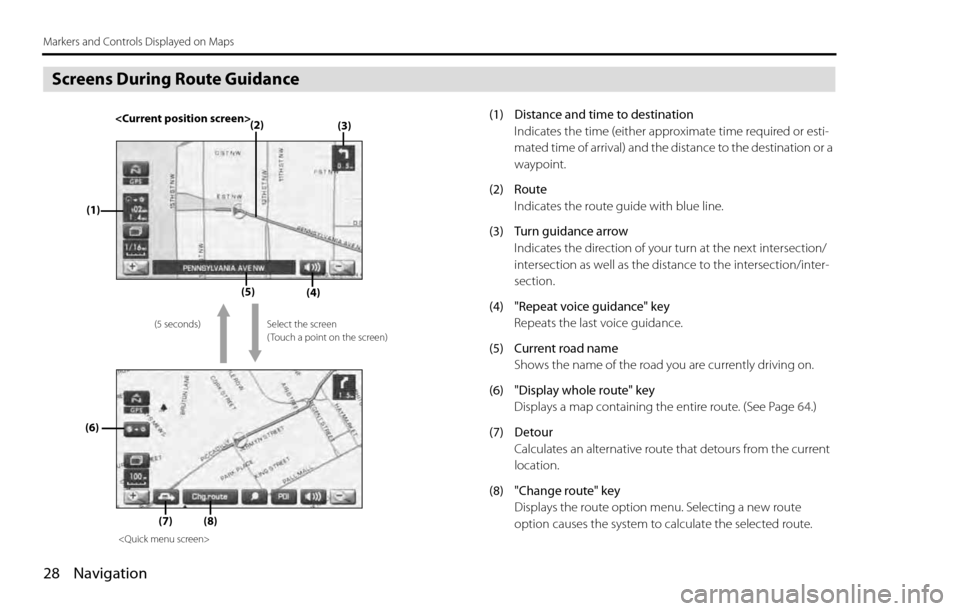
28 Navigation
Markers and Controls Displayed on Maps
Screens During Route Guidance
(1) Distance and time to destination
Indicates the time (either approximate time required or esti-
mated time of arrival) and the distance to the destination or a
waypoint.
(2) Route
Indicates the route guide with blue line.
(3) Turn guidance arrow
Indicates the direction of your turn at the next intersection/
intersection as well as the distance to the intersection/inter-
section.
(4) "Repeat voice guidance" key
Repeats the last voice guidance.
(5) Current road name
Shows the name of the road you are currently driving on.
(6) "Display whole route" key
Displays a map containing the entire route. (See Page 64.)
(7) Detour
Calculates an alternative route that detours from the current
location.
(8) "Change route" key
Displays the route option menu. Selecting a new route
option causes the system to calculate the selected route.(3)(2)
(1)
(4)(5)
(6)
(7)
Select the screen
( Touch a point on the screen) (5 seconds)
(8)
Page 15 of 90
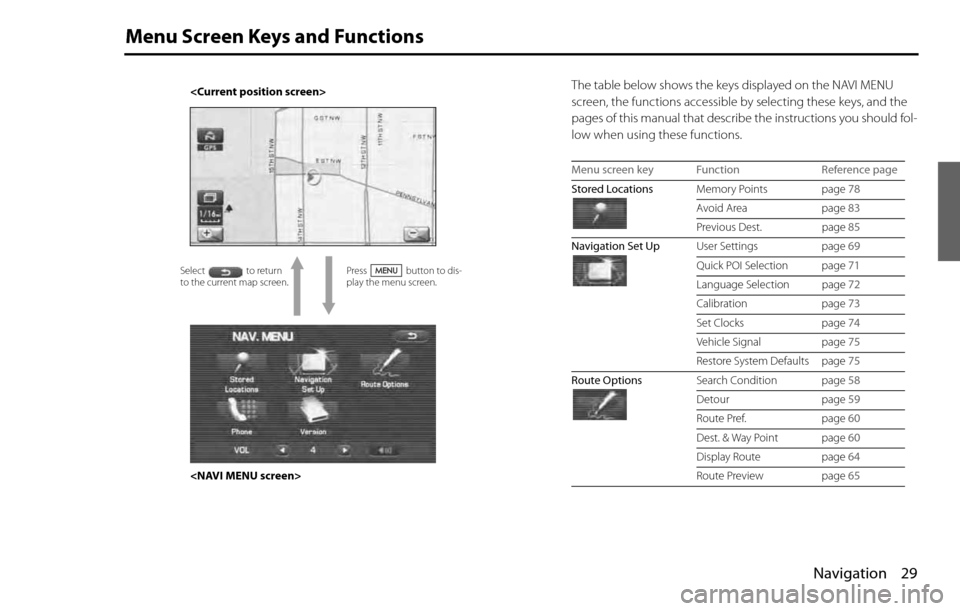
Navigation 29
Menu Screen Keys and Functions
The table below shows the keys displayed on the NAVI MENU
screen, the functions accessible by selecting these keys, and the
pages of this manual that describe the instructions you should fol-
low when using these functions.
Press button to dis-
play the menu screen.
Select to return
to the current map screen.
Menu screen key Function Reference page
Stored LocationsMemory Points page 78
Avoid Area page 83
Previous Dest. page 85
Navigation Set UpUser Settings page 69
Quick POI Selection page 71
Language Selection page 72
Calibration page 73
Set Clocks page 74
Vehicle Signal page 75
Restore System Defaults page 75
Route OptionsSearch Condition page 58
Detour page 59
Route Pref. page 60
Dest. & Way Point page 60
Display Route page 64
Route Preview page 65
Page 17 of 90
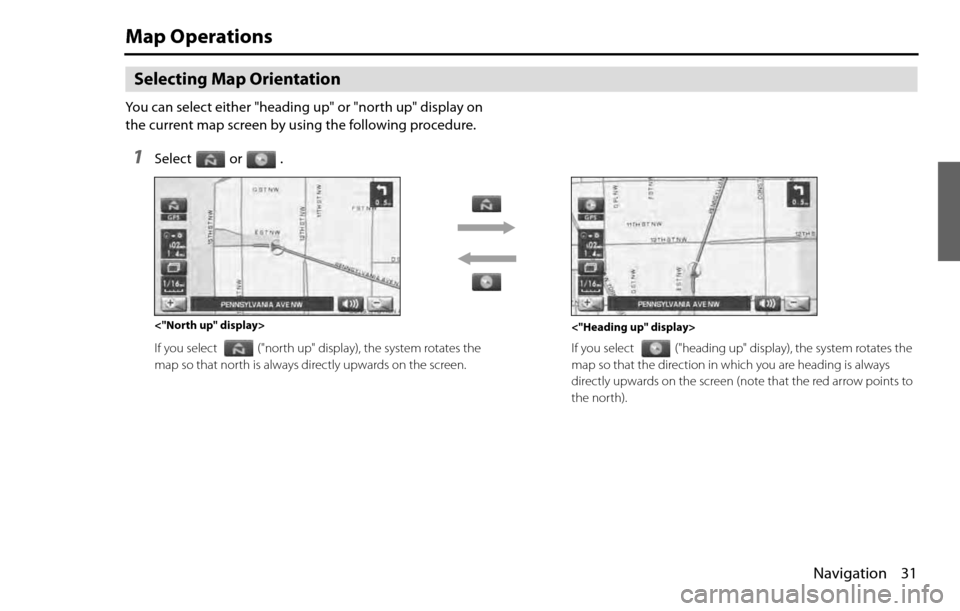
Navigation 31
Map Operations
Selecting Map Orientation
You can select either "heading up" or "north up" display on
the current map screen by using the following procedure.
1Select or .
If you select ("north up" display), the system rotates the
map so that north is always directly upwards on the screen.If you select ("heading up" display), the system rotates the
map so that the direction in which you are heading is always
directly upwards on the screen (note that the red arrow points to
the north).
<"Heading up" display> <"North up" display>
Page 19 of 90
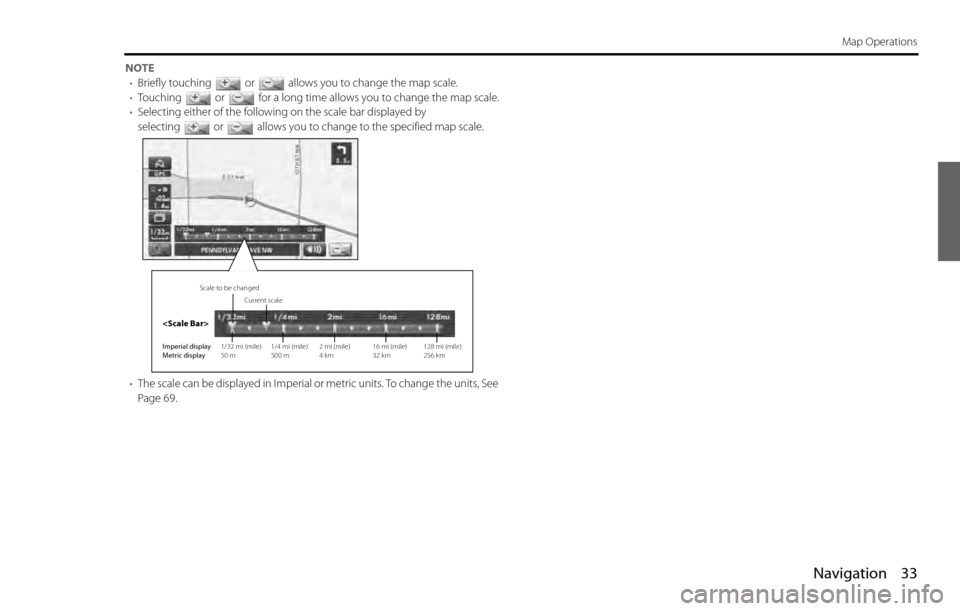
Navigation 33
Map Operations
NOTE
•Briefly touching or allows you to change the map scale.
•Touching or for a long time allows you to change the map scale.
•Selecting either of the following on the scale bar displayed by
selecting or allows you to change to the specified map scale.
•The scale can be displayed in Imperial or metric units. To change the units, See
Page 69
.
Imperial display
Metric display1/32 mi (mile)
50 m1/4 mi (mile)
500 m2 mi (mile)
4 km16 mi (mile)
32 km128 mi (mile)
256 km
Current scale
Scale to be changed
Page 20 of 90
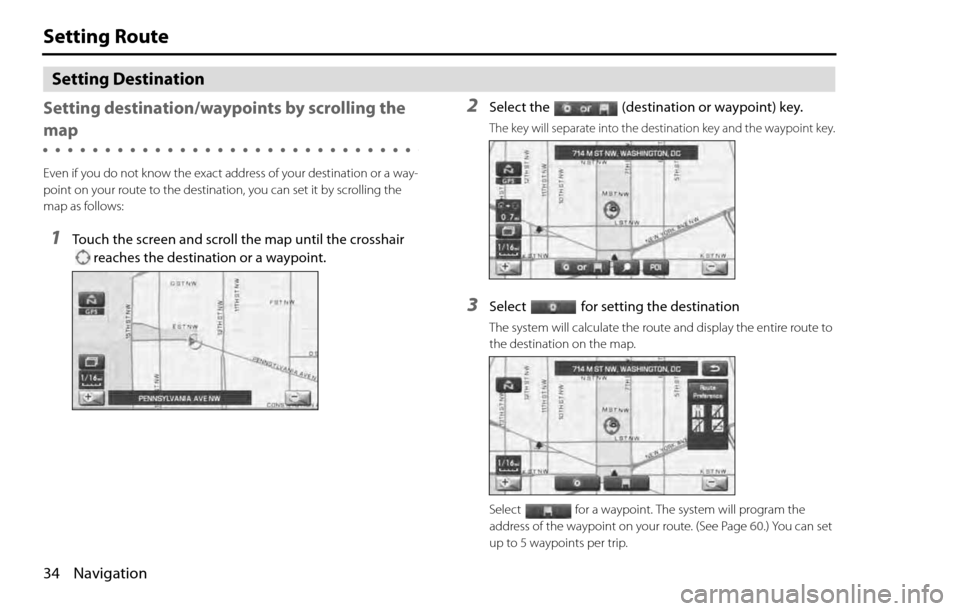
34 Navigation
Setting Route
Setting Destination
Setting destination/waypoints by scrolling the
map
Even if you do not know the exact address of your destination or a way-
point on your route to the destination, you can set it by scrolling the
map as follows:
1Touch the screen and scroll the map until the crosshair
reaches the destination or a waypoint.
2Select the (destination or waypoint) key.
The key will separate into the destination key and the waypoint key.
3Select for setting the destination
The system will calculate the route and display the entire route to
the destination on the map.
Select for a waypoint. The system will program the
address of the waypoint on your route. (See Page 60.) You can set
up to 5 waypoints per trip.
Page 21 of 90
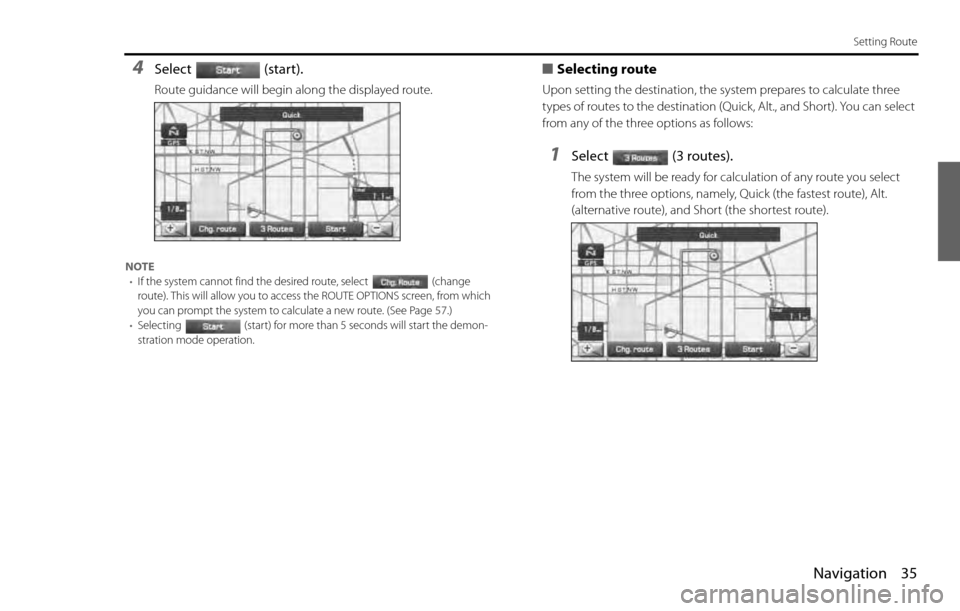
Navigation 35
Setting Route
4Select (start).
Route guidance will begin along the displayed route.
NOTE
•If the system cannot find the desired route, select (change
route). This will allow you to access the ROUTE OPTIONS screen, from which
you can prompt the system to calculate a new route. (See Page 57
.)
•Selecting (start) for more than 5 seconds will start the demon-
stration mode operation.
■Selecting route
Upon setting the destination, the system prepares to calculate three
types of routes to the destination (Quick, Alt., and Short). You can select
from any of the three options as follows:
1Select (3 routes).
The system will be ready for calculation of any route you select
from the three options, namely, Quick (the fastest route), Alt.
(alternative route), and Short (the shortest route).
Page 22 of 90
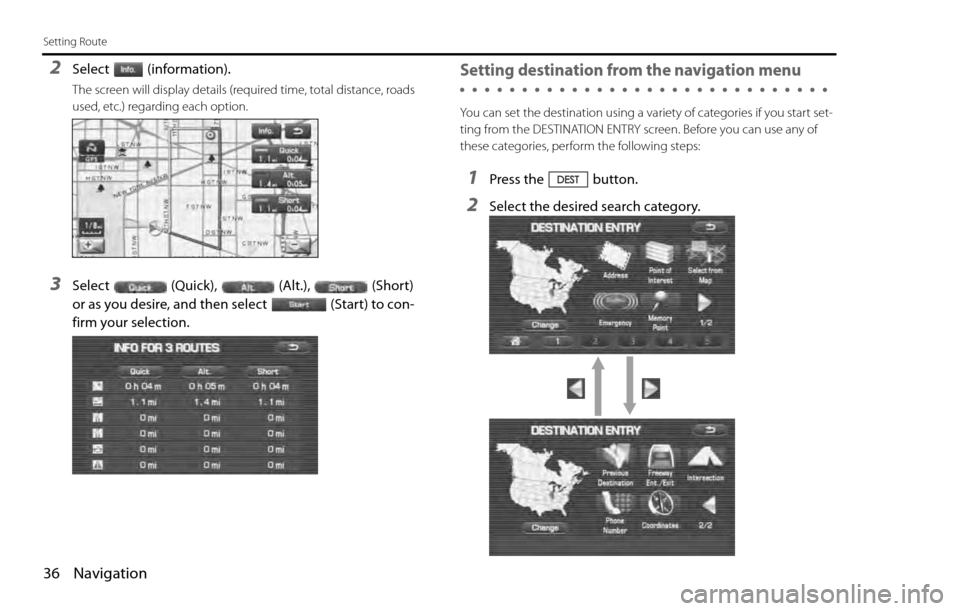
36 Navigation
Setting Route
2Select (information).
The screen will display details (required time, total distance, roads
used, etc.) regarding each option.
3Select (Quick), (Alt.), (Short)
or as you desire, and then select (Start) to con-
firm your selection.
Setting destination from the navigation menu
You can set the destination using a variety of categories if you start set-
ting from the DESTINATION ENTRY screen. Before you can use any of
these categories, perform the following steps:
1Press the button.
2Select the desired search category.
Page 23 of 90
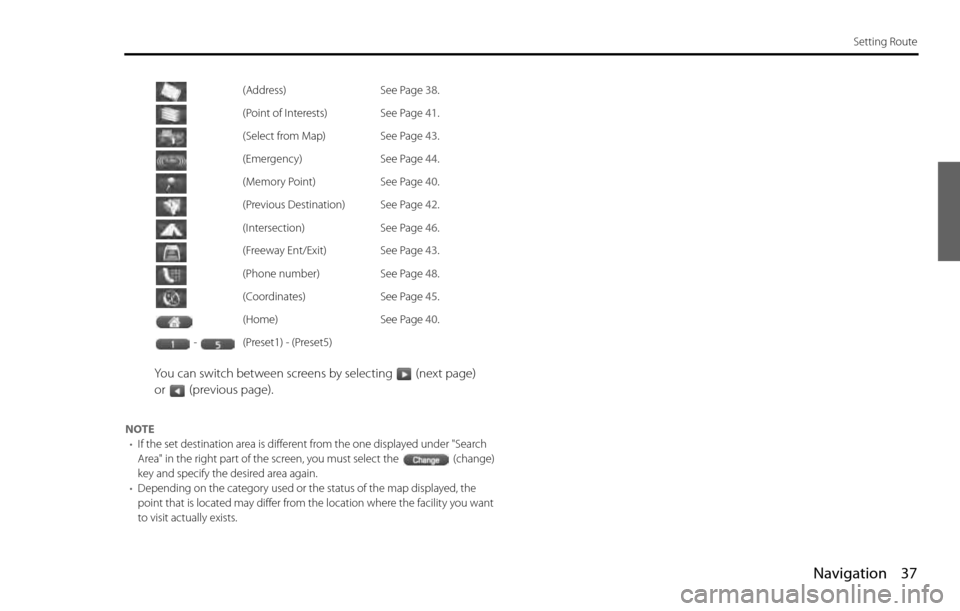
Navigation 37
Setting Route
You can switch between screens by selecting (next page)
or (previous page).
NOTE
•If the set destination area is different from the one displayed under "Search
Area" in the right part of the screen, you must select the (change)
key and specify the desired area again.
•Depending on the category used or the status of the map displayed, the
point that is located may differ from the location where the facility you want
to visit actually exists.(Address) See Page 38
.
(Point of Interests) See Page 41
.
(Select from Map) See Page 43
.
(Emergency) See Page 44
.
(Memory Point) See Page 40
.
(Previous Destination) See Page 42
.
(Intersection) See Page 46
.
(Freeway Ent/Exit) See Page 43
.
(Phone number) See Page 48
.
(Coordinates) See Page 45
.
(Home) See Page 40
.
- (Preset1) - (Preset5)
Page 25 of 90
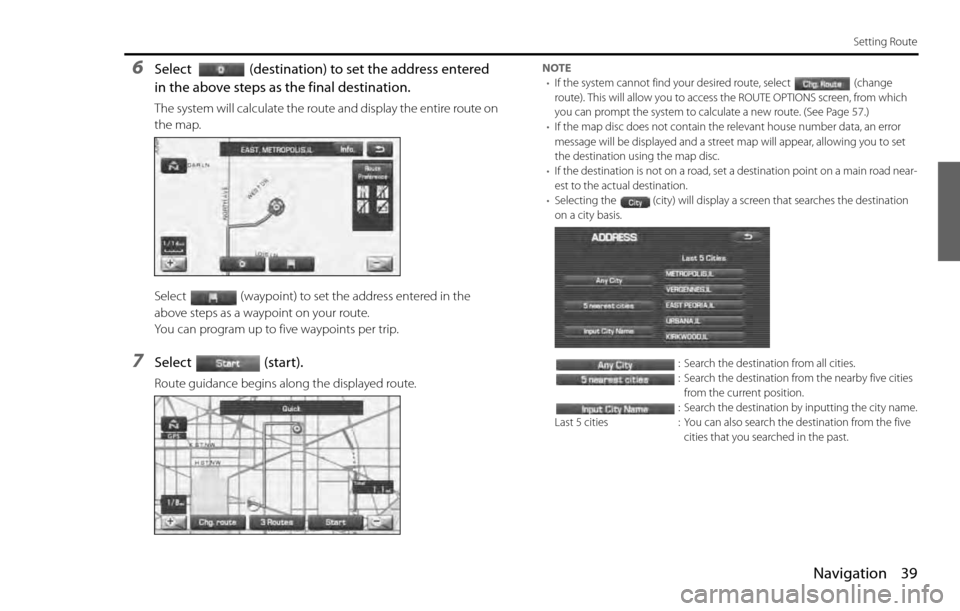
Navigation 39
Setting Route
6Select (destination) to set the address entered
in the above steps as the final destination.
The system will calculate the route and display the entire route on
the map.
Select (waypoint) to set the address entered in the
above steps as a waypoint on your route.
You can program up to five waypoints per trip.
7Select (start).
Route guidance begins along the displayed route.
NOTE
•If the system cannot find your desired route, select (change
route). This will allow you to access the ROUTE OPTIONS screen, from which
you can prompt the system to calculate a new route. (See Page 57
.)
•If the map disc does not contain the relevant house number data, an error
message will be displayed and a street map will appear, allowing you to set
the destination using the map disc.
•If the destination is not on a road, set a destination point on a main road near-
est to the actual destination.
•Selecting the (city) will display a screen that searches the destination
on a city basis.
: Search the destination from all cities.
: Search the destination from the nearby five cities
from the current position.
: Search the destination by inputting the city name.
Last 5 cities : You can also search the destination from the five
cities that you searched in the past.
Page 26 of 90
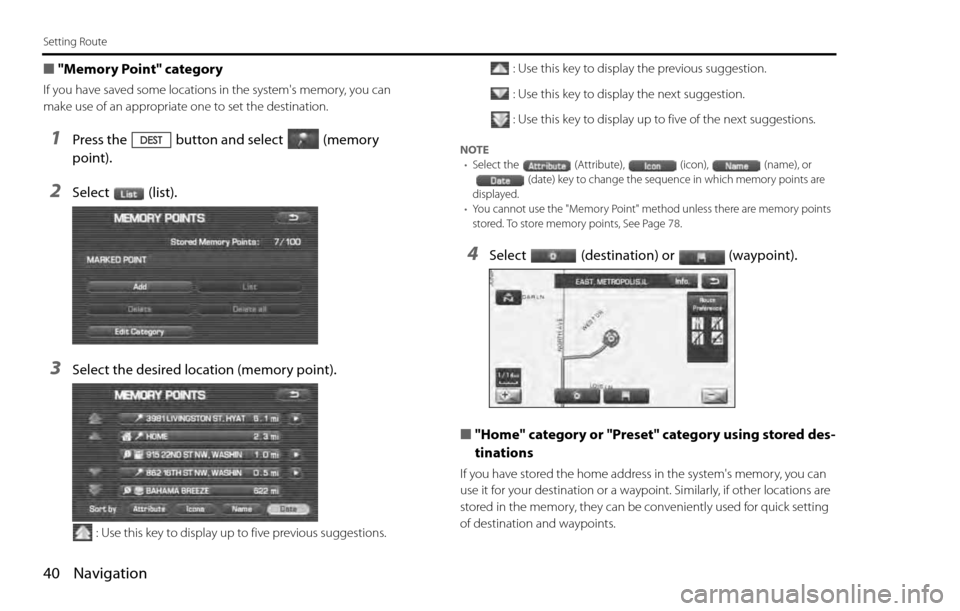
40 Navigation
Setting Route
■"Memory Point" category
If you have saved some locations in the system's memory, you can
make use of an appropriate one to set the destination.
1Press the button and select (memory
point).
2Select (list).
3Select the desired location (memory point).
: Use this key to display up to five previous suggestions.: Use this key to display the previous suggestion.
: Use this key to display the next suggestion.
: Use this key to display up to five of the next suggestions.
NOTE
•Select the (Attribute), (icon), (name), or
(date) key to change the sequence in which memory points are
displayed.
•You cannot use the "Memory Point" method unless there are memory points
stored. To store memory points, See Page 78.
4Select (destination) or (waypoint).
■"Home" category or "Preset" category using stored des-
tinations
If you have stored the home address in the system's memory, you can
use it for your destination or a waypoint. Similarly, if other locations are
stored in the memory, they can be conveniently used for quick setting
of destination and waypoints.